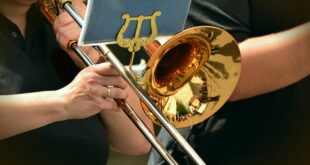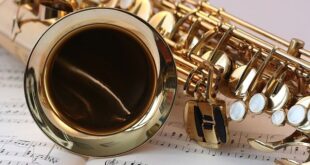The saxophone can be a difficult instrument to master especially with all the techniques that go into playing the J-shaped horn. The steep learning curve also contributes to this. However, it might be one of the easiest and smoothest learning experiences depending on the type and make of the horn you choose to use. Just as how guitar nerds like to fight over technicalities and gear, in the saxophone world this is just as much as it is true as it is over at guitar world. A low-quality horn might throw you off playing in the first place. With that being said, Let’s delve into the matter.
When it comes to studying saxophone, the alto saxophone is by far the most popular choice – especially for younger players who may find the tenor too hefty.
We’ll walk you through some of the greatest alternatives for your first beginner alto sax in this article.
The alto saxophone is significantly lighter and easier on the fingers than the tenor and baritone saxes, and while the smaller soprano saxophone may appear tempting at first look, it is notoriously difficult to master in terms of embouchure, tuning, and sound. Choosing a first alto sax as a novice, on the other hand, maybe a difficult process.
In comparison to the world of higher-end horns, the student saxophone market is saturated with a plethora of manufacturers and models fighting for attention. While it is true that you get what you pay for in most cases, there are some saxophones that provide far greater value for money than others.
So, spanning a variety of brands and price points, we’ve compiled a shortlist of some of the finest beginning alto saxophones, followed by a comprehensive evaluation of each one.
But first, we have to highlight the obvious and the not so obvious differences between the common varieties of saxophones available on the market.
Table of Contents
Size
The size of the two instruments is the most noticeable distinction between them. The tenor sax is somewhat bigger and heavier than the alto sax, which is smaller, lighter, and easier to wield. The neck of an alto saxophone rises slightly towards the end, whereas the neck of a tenor falls somewhat. Aside from aesthetics, the size of the two instruments affects the sounds they generate.
Because the alto sax is smaller than the tenor sax, its notes are higher and brighter. Tenor saxophones have a mellow, rich, and deep tone. While skilled performers can obtain a wide range of sounds from both instruments, younger artists with smaller hands and lungs have an easier time playing the alto sax.
Transposing Instruments
The alto and tenor saxophones are both transposing instruments, which means they do not sound the same as the piano or other concert pitch instruments. The pitch of a transposing instrument is written differently from what is actually generated in written music; for example, performing a written C on a transposing instrument will result in a pitch other than C. They’re more similar in nature than most people realise because they have the same key locations, fingerings, number of notes, and both require a reed and a mouthpiece to perform. Because the alto and tenor saxophones are the two most popular instruments in the saxophone family, many professional musicians learn both to increase their marketability.
Differences in Register
Although the alto and tenor saxophones have comparable fingerings and embouchures, they have a substantial difference in note register. Because the alto saxophone is an E-flat instrument, a written C performed by an alto saxophone really sounds like an E-flat. The tenor saxophone, on the other hand, is half an octave lower in pitch. It’s composed in B-flat, thus a written C for the tenor sounds like a B-flat. Although this is a significant difference between the two instruments, it is only evident when playing your tenor sax with sheet music written for an alto sax and vice versa.
Accessories
Because the alto and tenor saxophones are so close in nature, the key accessories you’ll need to buy are almost identical. Whatever saxophone you choose, you’ll need to get the following accessories: a strong case, additional reeds, a mouthpiece, and cleaning cloths. While a metronome and a music stand are optional extras, you may find that your youngster will appreciate learning a new instrument more if these items are accessible. If you need help caring for and maintaining your saxophone, ask your music instructor or a local repair specialist for specialised guidance.
Which is Better for a New Musician?
The alto saxophone’s lower size makes it an excellent choice for younger pupils. Because it needs a smaller and tighter embouchure, the mechanics of the alto sax are simpler for novice performers to comprehend before progressing to larger saxophones. If your kid is little, the alto sax’s low physical requirements make it a great first saxophone for young players. If you’re looking for a saxophone based on genre, virtually every variety of saxophone is utilised in jazz music, but the tenor is the most commonly used; hence, if your youngster appears to be mainly interested in performing jazz, the tenor sax is a better choice.
Cheap Horn vs. Expensive Horn (Does the price matter?)
- The Palm Keys on Cheap Saxophones Will Have a Lot of Travel
With the palm keys, there will most certainly be a lot of movement to get to that D key in particular. To get to that D, you’ll nearly have to bend your hand. And when you get there, the palm key may stay moving for a while, implying that it has to open a long way to for the D to come out. The issue with palm keys that have a lot of movement is that once pushed, your index finger is miles away from the B key on the other side.
- The Palm Keys on Cheap Saxophones Will Not be Uniform
If the palm keys are not consistent, it might be difficult to get the other keys down once you’ve mastered the D. To discover all three palm keys, you must really work your hand. The palm keys on high-end professional saxophones will be precisely where you anticipate them to be. You don’t have to spread your fingers or open your hand to get to a D.
- The next thing is in the feel of the saxophone.
When you hold the saxophone, the front keys of the left hand will feel uncomfortable, and they will most likely be pointed in the incorrect direction.
Normally, they should be in a position where the keys are directly beneath your fingertips, but there are no assurances with inexpensive saxophones.
And, given the usual layout of the front left keys of the saxophone, you may need to round your left fingers in order for your finger tips to rest on the keys. It will be uncomfortable for you to play in this position, and it will just not feel right.
- Also, be prepared for how far these keys will travel.
The left hand on expensive pro saxophones will sit nicely. The front keys will sit exactly where you expect them to be — right underneath your fingertips.
- The Octave Key on Cheap Saxophones Might Have a Lot of Travel
The octave key will also have quite a lot of travel as well. As you play and move between the octaves, you’ll have a lot of distance to get that down. The octave key on an expensive saxophone, even when slightly worn won’t have a lot of travel, and there’ll be slightly more padding on it.
- The Front Right Keys on Cheap Saxophones Might Also Be Misplaced, Feel Awkward
In terms of travel, the same may be stated about the right hand. The B# key on the side will be very far away from your knuckle. These are the kinds of things that will cause you to make mistakes while moving between the side B# and the front keys on your saxophone.
There will be a lot of movement in your fingers to get the B flat out. The greater the distance travelled, the more deformed your fingers and hand posture will be.
The keys on the front will also not feel correct. Your fingers don’t seem to be resting naturally on the keys. If you’re used to playing professional saxes, you’ll notice the difference the moment you pick up a cheap saxophone.
- The Side Keys on Cheap Saxophones Will Gradually Get Closer and Closer to The Saxophone
On cheap saxophones, the side keys will gradually get closer and closer to the body.
Typically, the top one won’t be too bad even though it will sit too far away from your fingers, but as you get lower and lower, to the B#, they will come in further and further away.
The lay of cheap saxophones is almost always never go on the side keys.
- Cheap Saxophone Brands Change Rapidly
The thing to remember with inexpensive saxophones is that brands come and go fairly quickly. A cheap saxophone brand will only survive a few years before being replaced by something new. It could possibly return! This makes it difficult to track the quality of these instruments over time because they are continuously changing, even whether they come from the same manufacturing in China or elsewhere.
- With Quality, You Might Get Lucky with a Cheap Saxophone
In general, it’s difficult to propose low-cost saxophones. They are, indeed, extremely inexpensive. And, to be honest, they don’t sound that awful. However, all of the information we have from repairers and other players who have acquired these low-cost saxophones (mainly online) indicates that the quality can vary greatly.
You could get lucky and get a cheap saxophone in fine condition, but you might also find one that has to be repaired right away. A low-cost saxophone is a risk.
In fact, most repairers who work on these low-cost instruments claim that they simply do not last.
- Cheap Saxophones Come with Bad Cases and the horn moves around inside the case.
If you want to save some money on an instrument, that’s fine. But please put it in a better case so it doesn’t constantly get impact damaged.
If you’re shipping a cheap saxophone from, say, Amazon, the case it comes in is awful; expect some impact damage. Occasionally, keys will come off and bounce around in the case during delivery. Ouch!
Even if you repair your inexpensive saxophone once it arrives and make it ready to play, then put it back in the same case and carry it around, it’s just as likely to get broken again. The first thing you get with a high-priced pro sax is a good case. When you spend more money on an instrument, you may expect it to come with a nice functional useable casing.
Cheap Saxophone Play Surprisingly Well
Okay. This is more of a benefit than a disadvantage. The majority of low-cost saxophones perform remarkably well — almost astonishingly well (even with their mouthpieces). They don’t sound half terrible throughout the entire range for the price, and they play in tune. However, I believe there is a significant difference in sound between a cheap saxophone and a professional saxophone.
Is a cheap saxophone worth it? Is an expensive professional saxophone worth the extra money?
To be honest with you, cheap saxophones are completely useless. You’ll be surprised by the sound, sometimes it actually won’t sound too bad at all, especially if you don’t use the mouthpiece that came in the case. The mouthpiece does make a huge difference to the sound.
What would I recommend instead of a cheap saxophone?
I would jump on to an online classified website is in your area and check out a second-hand professional saxophone.
Why?
They’re really inexpensive, they sound amazing, and they have a legendary reputation for being incredibly dependable, and you’re taking just as big of a chance with a cheap buy anyhow.
You won’t pay much more, if anything, on a used pro saxophone than you would on one of those cheap saxophones, but you will receive a saxophone that has been tried and proven for decades, something that both beginners and pros like.
Best Saxophones For Beginners
Now that we’ve established that professional alto saxophones are obviously the superior choice; it is only natural to present you, the reader with a few reasonable contenders.
Montreux is a well-known company that produces high-quality symphonic brass and woodwind instruments. Montreux also sells woodwind and brass instrument accessories such as stands, cleaners, and mouthpieces.
The brand was created with students and novices in mind, and it has been tried and tested in educational settings for several years.
The saxophone comes with everything you need to get started, including a mouthpiece and reed. All of these are included in the case, making it a perfect beginning bundle for novice artists.
The high F# key is already installed on this Montreux instrument, allowing for a wider range and is frequently mentioned as a necessity by sax instructors.
This student saxophone comes with a tough and dependable travel bag, allowing you to transport your instrument safely and comfortably thanks to the back pack type straps. Everything you need to get started playing your new instrument is included.
A high-quality student saxophone that comes highly recommended by teachers and is ideal for beginning players.
Because of the quality and power of the pads and keywork, the Montreux instruments are popular among students and novices.
The next item on our list is a FOVERN portable saxophone. The lightweight portable design and small size make it easy to transport as the ideal practise tool that it is.
With the alto mouthpiece, the portable sax becomes an easy-to-play instrument with a tone that is strikingly similar to that of a genuine sax. If you can play the alto saxophone, you can also play the soprano saxophone.
The tiny pocket sax is composed of ABS material, which makes it strong and durable, with an excellent service life.
It also includes 8 sax dental pastes to protect the saxophone and keep your teeth comfortable.
The Nuvo jSax opens up the world of saxophone playing to a far larger audience than ever! Young musicians can now begin playing an instrument with a traditional feel at a young age.
The jSax, like all other Nuvo instruments, is tuned in C (concert pitch), making incorporation into classroom music creation a breeze. The instrument has a chromatic range that extends from middle C (C4) to G in the following octave up (G5).
The jSax is available in a variety of colours to appeal to everyone!
How does jSax differ from a conventional soprano saxophone?
The jSax features a conventional fingering technique and is designed to help novices acquire embouchure and tuning abilities that will transfer immediately to a full-size saxophone. Because the tone is unexpectedly mild, this instrument is a lot of fun for both novices and experienced amateur saxophonists.
It’s worth noting that Nuvo Instrumental provides a variety of single reed instruments, all of which can assist you build the abilities needed to go to clarinet and saxophone playing later on.
This is an excellent resource for beginners who want to learn how to play this wonderful instrument.
The sound is excellent, not quite on par with that of a conventional sax, but far superior than one’s expectations. Low sounds that are both deep and warm.
Overall, I recommend it to people who are new to the game or wish to invest a small amount of money.
Last but not least is the Odyssey OAS130 Alto. This is a high-quality alto saxophone. This horn is a very popular entry-level instrument with a durable, attractive polished gold clear lacquer brass body, engraved bell, power forged keywork, stainless steel rods, springs, and pins, perloid keycaps, high F# key, single braced pad cup on low C, fine tuning adjustment, quality pads and mouthpiece, and adjustable thumb rest.
The Brass body Odyssey ‘Debut’ Eb Saxophone comes with cork grease, a locking premium neck strap, a reed, and an instruction manual. The ABS Hard Case is light, sturdy, and long-lasting, with a plush-lined, snug-fit black inside with a comfort carry handle.
The OAS130 is an inexpensive, popular choice around the UK for amateurs and beginners who are just getting started. Odyssey instruments are distinguished by generations of experience, accurate design, current hi-tech production processes, rigorous quality control, continuous attention to detail, and a personal touch.
Outstanding instruments for both beginning and expert musicians. Master Craftsman Peter Pollard meticulously constructed the OAS130 Debut Alto Saxophone to achieve an instrument of breath-taking excellence.
The Odyssey Debut Alto Saxophone is built to the finest standards, with Euro Stainless-steel rods, springs, and pins for increased quality and dependability.
The Odyssey Debut Alto Saxophone is intended to help novice players on their musical journey. Everything is geared at making the instrument simple to play and pleasant to carry. Power forged keys and a High F# key is included.
The Odyssey Debut Alto Saxophone is not only a fantastic instrument to play, but it is also stunning to look at. It boasts a gorgeous brass body with a lacquered finish, as well as a lovely engraved bell and period key caps.
The Odyssey Debut Alto Saxophone has everything you need to get started, including a mouthpiece, cap, ligature, reed, strap, and cleaning supplies, all housed in a lightweight ABS hard case exactly contoured to the shape of the saxophone.
 The Occasional Orchestra Learn About Everything Music!
The Occasional Orchestra Learn About Everything Music!





